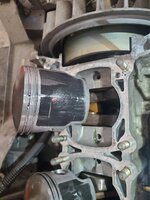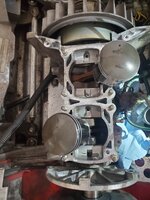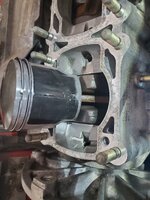Small update for those still interested. After getting some other projects completed, I wanted to revisit this sled. Looking at two things: engine/clutch performance and the stiff-turning track.
Stiff track:
I've got the skid out and the only two things I've found that would make the track hard to turn by hand are a gritty feeling driveshaft bearing (PTO side) and a warped brake rotor. I have pulled the pads out and the track was still hard to turn in spots, so I am ignoring the rotor for the time being. The jackshaft bearings check out and the chaincase side driveshaft bearing feels great. There is no way that the driveshaft bearing being a little rough would make the track hard to turn...though I am replacing it, of course. Would like some closure on this but not sure I'll get it... Damn thing feels like the parking brake is on sometimes. It wouldn't even roll down my old tilt trailer, when my other sleds would. Anyway...
On the engine/performance side of things:
I pulled the secondary clutch apart and cleaned it. All looks great inside! Has the correct spring (Silver) and everything slides smoothly. The buttons are a bit worn, so I am replacing them while I'm in there.
Ordered a puller for the primary, but disassembled it as much as I could and found that the clutch cover bushing has all kind of gouges in it. The shaft doesn't appear to have any big marks on it, but the cover does not slide smoothly at all. The weights all move freely and everything else appears serviceable. Has the correct spring (Dark Blue/White), but considering replacing or changing. Will probably order buttons...would be silly not to.
The clutch cover bushing wasn't coming out easily, so I came across this while looking for a removal tool or a new or rebuilt clutch:
https://gilomeninnovations.com/stock-oem-polaris-clutch-cover-for-p90-standard-primary-clutch/
For $40, I will just order a new cover w/ bushing...I am assuming they didn't change much over the years...the bushing/cover design is the same, visually. Also, I had no idea how old the drive belt is, so that has been ordered as well, so we are starting as fresh as reasonable.
The other little project is that I have decided to install a tach in the factory blank spot. I think I've found a compatible one, so I'm excited to get it installed. Should help troubleshooting immensely! For all I know, the 'loud exhaust' was due to the engine at max RPM just to start moving. Based on the clutch cover issues, I could see that being the case. There will be no question now.








